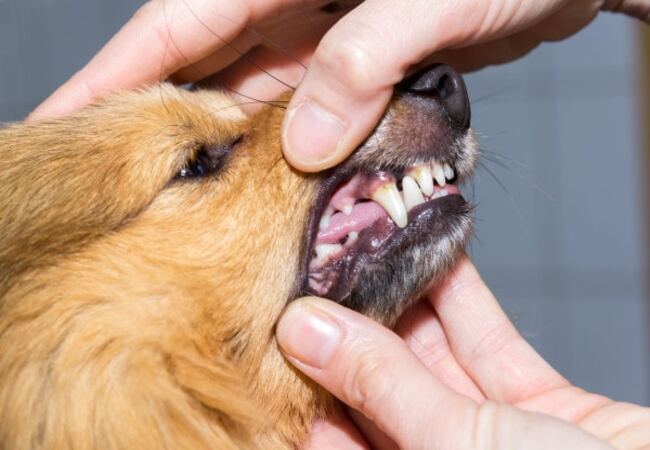Vet’s 2025 Guide to Red Gums in Dogs Causes, Diagnosis & Home Care 🩺

In this article
Vet’s 2025 Guide to Red Gums in Dogs Causes, Diagnosis & Home Care 🩺
By Dr. Duncan Houston BVSc
💡 Why Gum Color Matters
Healthy dog gums are typically bubblegum-pink, smooth, and moist. Deviations—even red gums—can signal local dental problems or systemic issues. Checking gums regularly offers early insight into health and hydration status via capillary refill time (CRT).
🚩 Common Signs to Observe
- Red, inflamed or swollen gums: often localized around teeth.
- Bleeding, bad breath, drooling, reluctance to eat hard food.
- Bright, uniform red gums or red spots (petechiae/ecchymoses).
- Emergency signs: panting, lethargy, collapse, neurological signs.
🔍 Common Causes of Red Gums
1. Gingivitis & Periodontal Disease
This is the most frequent cause—bacterial plaque and tartar buildup lead to inflammation, redness, swelling, and bleeding gums. Advanced disease can ignite abscesses, loose teeth, and organ issues.
2. Gum Injury or Trauma
Chewing hard objects/toys may cut gums, causing localized redness or bleeding.
3. Heat Stroke & Overheating
Elevated body temperature causes brick‑red gums, prolonged CRT, panting, collapse—an emergency.
4. Immune‑Mediated or Platelet Disorders (ITP)
Low platelets cause spontaneous bleeding, petechiae (tiny red spots) or ecchymoses on gums—a critical emergency.
5. Toxin Exposure
Carbon monoxide, rodenticides, corrosive substances cause bright red or spotted gums.
6. High Blood Pressure (Hypertension)
Systemic hypertension makes gums appear redder due to increased capillary blood flow.
7. Sepsis or Systemic Infection
Widespread infection may present with warm, red gums despite low blood pressure—another urgent scenario.
8. Oral Growths or Hyperplasia
Gingival hyperplasia or papillomas may lead to red, swollen gums from chronic inflammation.
🧪 Diagnostic Approach
- History & examination: onset, eating habits, systemic signs, toxin access.
- Oral exam under sedation/anesthesia: visualize plaque, injury, tumors; dental X‑rays.
- CBC & chemistry: platelet counts, infection markers, organ function, electrolytes.
- Coagulation profiles: for suspected bleeding disorders or toxin gravitas.
- Blood pressure reading: if hypertension is suspected.
- Dental culture/biopsy: for tumors, gingival hyperplasia, and immune conditions.
🩺 Treatment Protocols
A. Dental & Oral Care
- Professional cleaning, scaling under anesthesia to treat gingivitis/periodontitis.
- Extractions if abscessed; gingivoplasty for hyperplasia.
- Home care: tooth brushing, chews, water additives, routine check‑ups.
B. Emergency Interventions
- Heat stroke: cool with tepid water, oxygen, IV fluids.
- Bleeding disorders: prednisone/immunosuppressives for ITP, platelet transfusion if severe.
- Coagulant toxins: vitamin K therapy, transfusions, supportive care.
- Hypertension: antihypertensives, treat underlying disease.
- Sepsis: aggressive IV fluids, antibiotics, hospitalization.
C. Oral Growths
- Surgical removal or laser ablation of papillomas/hyperplasia.
- Biopsy and further therapy (e.g., immunosuppressives) if indicated.
🏡 Home Monitoring & Ask A Vet Support
- 📅 Log gum color, eating behavior, drooling, and breath changes.
- 🕒 Reminders for oral hygiene routines, meds, and follow-ups.
- 📸 Upload photos for early vet assessment of redness or spots.
- 🔔 Alerts for emergency signs—bleeding, collapse, panting.
- 📚 Guided care: dental hygiene technique tutorials, heat safety, wound management.
🔍 Key Takeaways
- Red gums are most common from gingivitis but may signal emergencies like heatstroke, bleeding disorders or sepsis.
- Spotted or uniformly bright red gums need prompt evaluation and blood tests.
- Regular dental care and routine checks prevent many oral issues.
- Home monitoring via Ask A Vet helps catch changes early and supports ongoing care.
🩺 Conclusion ❤️
In 2025, noticing red gums can be a simple sign of dental issues—or a red flag for life-threatening conditions. With routine dental care, swift response to emergencies, and home support via the Ask A Vet app, owners can ensure their dogs’ mouth and overall health thrive. 🐾✨
Visit AskAVet.com and download the Ask A Vet app to log gum checks, set reminders, share photos with your vet, and get support for oral hygiene and emergencies—right from your home. 📲






